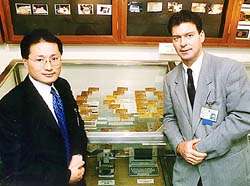



















|
| |
 Leave home without it. Commercial Crime Bureau Counterfeit and Forgery Division's Detective CIP Anita Yip Lai-wan, flanked by Station Sergeant Chan Yuk-man and Detective SIP Helen Wong Poon, display phoney credit cards confiscated from Law's fake credit card factory |
Recently Hong Kong resident Law Yuen-chung was sentenced to life in prison in China thus
ending a remarkable case that would bring together members of the Force's Counterfeit and
Forgery Division, the Guangzhou Public Security Bureau, the credit card industry's security
division and the Canadian Combined Law Enforcement Unit in a concerted effort that shut
down the world's biggest fake credit card factory
IN early 1993, the Canadian Combined Law Enforcement Unit developed information that they had on a Hong Kong resident named Law Yuen-chung who was in the process of purchasing a steam press laminator in Toronto. Such a five-tonne press is a legitimate apparatus used for a variety of applications in the world of imprinting. |
|
What made Canadian lawmen suspicious was Law's previous criminal record in Hong Kong and the fact that the primary function of the gigantic piece of machinery was to press/affix laminate onto common bank credit cards. Since Law Yuen-chung was neither involved in the banking, plastics or printing industries, Canadian Combined Law Enforcement Unit personnel began to monitor him and his new - and rather expensive - acquisition. In mid-1993, Law shipped the laminator from Toronto to Hong Kong, but before clearing customs the Canadians secretly marked its hydraulic press so that Hong Kong Police (whom they contacted) could identify it once it arrived. "Our information on Law, and that shared by the Canadians, led us to believe that his intention was to set up a fraudulent credit card factory in Hong Kong," recalled Detective Chief Inspector Peter Barnes of the Commercial Crime Bureau's Counterfeit and Forgery Division. "So, with the assistance of our Criminal Intelligence Bureau, we monitored both the delivery of the laminator press to Hong Kong and Mr Law's movements." But rather than setting up shop in Hong Kong, Law Yuen-chung moved the press into Shenzhen. Hong Kong Police informed the Public Security Bureau in Shenzhen about the movement, and they in turn began to monitor events - which remained uneventful for quite some time. Things started to heat up again when the Counterfeit and Forgery Division discovered that high quality fake holograms linked to Mr Law were being manufactured in Guangdong. The officer-in-charge of the case, CIP CS 2 CCB Anita Yip Lai-wan, quickly provided details to the Guangdong Public Security Bureau, who after monitoring the situation confirmed Counterfeit and Forgery Division's suspicions that Law Yuen-chung had set up a counterfeiting workshop somewhere in Guangzhou. Hong Kong Police decided to intensify their focus on Law, and in July 1996 they noticed that he was not only travelling between Hong Kong and Guangzhou on a regular basis, he was also going to the US, particularly to Phoenix, Arizona. Because Phoenix is a centre of computer chip manufacturing, the officers were starting to get an inkling of just how sophisticated and big Law's counterfeiting operation might be. They were also concerned that Law was going to the States to get credit card data that included legitimate card holders' names and numbers to be used on his fake cards. "We then arranged with the credit card industry and the Guangzhou PSB to closely monitor Law," explained Mr Barnes. "In fact, this case was proving to be a great example of what can be achieved through liaison work. The ties that were formed between the Public Security Bureau, the credit card industry and the Hong Kong Police during this case would be invaluable in terms of prevention or detection and apprehension of criminals in any future cases. We've established phenomenal trust." Law returned to Hong Kong from Phoenix on 9 July 1996. Almost two weeks later, on July 22, he slipped into the mainland at the Lo Wu crossing. Law's movement in the mainland was being monitored by the PSB Guangzhou. The next day, on 23 July, PSB Guangzhou raided a residence in that city where Law was apprehended together with a mainland male accomplice. Police officials were stunned at the enormity of Law's operation. "There's various stages to the manufacture of credit cards and usually they are carried out at different locations," explained Mr Barnes. "There's the base card factory where the basic white plastic card is made; and then there are the embossing and encoding factories where the magnetic stripe, holograms and so forth are put into the cards and the numbers and other information embossed onto them. But Law's Guangzhou factory was doing the whole process in one location. I don't think there will ever be a bigger counterfeit credit card factory anywhere. Certainly, we have never dealt with a case on such a grand scale." | |
|
Seized in the raid on the residence in Guangzhou were 3,500 cut base cards bearing counterfeit JCB, VISA, Mastercard, Diners Club and Amex faces; 10,000 uncut base cards, which are big plastic sheets that are cut up into dozens of cards; 14,000 Mastercard holograms; 14,000 Visa holograms; an embosser, an encoder, a hot-stamping machine, lap-top computer and a hand gun. The Counterfeit and Forgery Division's counterfeit expert (now CIP ADVC SSPO David Wan Duk-wai), who was also heavily involved in the case, travelled with Detective CIP Barnes to the mainland on several occasions so that he could advise PSB officials and perform forensic examinations on the cards to prove that they were counterfeit. "The quality of the cards was excellent, and all their numbers were legitimate," recalled CIP Wan. "They were destined mainly for Europe, the US and Japan. Some were used in Hong Kong as well. Since the neutralisation of Law's factory, there has beem a drastic drop in the number of counterfeit credit cards not just in Hong Kong, but globally. The day after the factory raid, the PSB picked up two more male suspects and a mainland female who was the designer and printer of the cards. She knew how to operate all the equipment and had the basic plastic knowledge to manufacture the cards. Following the arrests in China, the Commercial Crime Bureau mounted raids in Hong Kong and arrested three people, one of whom was wanted by Hong Kong Police for jumping court bail for a secondary credit card factory case. "The main success of the case was the co-operation that existed and grew between our colleagues in Canada, the credit card industry, the Hong Kong Police and the Public Security Bureau in Guangzhou," said Detective CIP Barnes. "Without those agencies working as closely together as they did, we would have never neutralised the world's largest counterfeit credit card factory." |  The Counterfeit and Forgery Division's counterfeit expert (now CIP ADVC SSPO David Wan Duk-wai) with Detective CIP Peter Barnes
|

